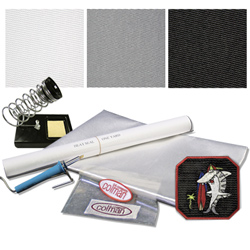Creating Custom Patches with a Commercial Embroidery Machine
As someone who loves to sew and embroider, you may be wondering how you can create custom patches with a commercial embroidery machine.
Luckily, it’s not as difficult as you might think! With a few simple supplies and some creativity, you can make beautiful patches for any project.
Custom Patches are Profitable
Custom patches are a great way for small businesses to make extra profits. By allowing customers to choose their own designs, businesses can tap into a whole new market of customers who want to express their individual styles.
 In addition, custom patches can also be used to promote special events or promotions. For example, businesses could create a limited edition patch to commemorate the opening of a new store or the launch of a new product. By offering these unique products, businesses can quickly boost their bottom line.
In addition, custom patches can also be used to promote special events or promotions. For example, businesses could create a limited edition patch to commemorate the opening of a new store or the launch of a new product. By offering these unique products, businesses can quickly boost their bottom line.
Custom patches are an easy and effective way for small businesses to stand out from the competition and make extra profits.
Here are the supplies you’ll need:
– Embroidery machine
– Thread
– Fabric
– Scissors
– Iron or Heat Press
– Patch Material
– Tape (optional)
Now, let’s get started!
Decide on the design for your custom patch.
This can be anything from a simple shape to a complex logo or image. Once you have your design, digitize it using embroidery software. If you don’t have access to software, there are many online resources that can help you convert your image to a stitch file.
Deciding on the design for your custom patch can be a daunting task. There are endless possibilities, including printed sublimation patches and it can be hard to narrow down your options. However, there are a few things to keep in mind that will help you create a patch that you’re happy with. First, think about the purpose of the patch.
Are you trying to promote your business? commemorate an event? Or simply show off your personality? Once you know what you want the patch to achieve, you can start thinking about the design. Do you want something simple and elegant? Bold and eye-catching? Or something in between?
It’s also important to consider the size and shape of the patch. Will it be round, rectangular, or something more unique? And how big do you want it to be? Answering these questions will help you zero in on a design that’s perfect for you.
Cut Your Material to the Desired Size and Shape
If you’re using heat transfer vinyl, be sure to mirror your image before cutting.
When you are creating an embroidered patch, it is important to cut the material to the correct size and shape. If the patch is too large, it will be more difficult to sew and could end up looking bulky.
On the other hand, if the patch is too small, it will be difficult to see the details of the embroidery. In addition, the shape of the patch will affect how it looks when it is sewn onto a garment. For example, a square patch will have sharp corners, while a round patch will have softer edges.
Therefore, taking the time to cut the material to the correct size and shape is an important step in creating a professional-looking embroidered patch.
Secure Your Patch Materials to the Machine
When you’re ready to start embroidering, the first step is to secure your fabric to the embroidery machine.
This ensures that the fabric stays in place while the needle is moving, preventing any slippage or movement that could cause problems with the stitching. There are a few different ways to do this, but the most common method is to use an embroidery hoop.
The hoop holds the fabric taut, making it easier to produce clean, precise stitches. In addition, securing the fabric helps to prevent bunching or wrinkling, which can also affect the quality of the final product.
So, taking a few moments to properly secure your fabric before beginning to embroider is always time well spent.
Select the appropriate stitch settings for your design.
If you’re unsure, there are many helpful online resources that can guide you through the process.
Whether you’re working on a patch for a jacket or a bag, it’s important to choose the right stitch settings to ensure that your design looks great and lasts for a long time. One of the most important factors to consider is the type of fabric you’re using.
For example, if you’re embroidering on a delicate fabric like silk, you’ll want to use a lighter thread weight and smaller stitches to avoid damage. On the other hand, if you’re working with a sturdy fabric like denim, you can opt for a heavier thread and larger stitches.
Additionally, it’s important to think about how much wear and tear your patch will see. If it’s going to be subjected to a lot of friction, like from rubbing against a backpack strap, you’ll want to reinforce the edges with a border stitch or run stitch. By taking the time to select the appropriate stitch settings for your project, you can be sure that your embroidered patch will look great and last for years to come.
Start stitching!
Be sure to go slowly and carefully, especially if you’re new to machine embroidery.
There are a few things you’ll want to keep in mind. First, consider the type of fabric you’re working with.
Obviously, a thicker fabric will be more difficult to sew through than a thinner one. You’ll also want to take the stitch count into account – a higher stitch count will mean that your patch will be more durable, but it will also be more time-consuming to sew.
Finally, think about the overall design of the patch. Is it simple or complex? The more detailed the design, the more careful you’ll need to be while stitching. But no matter what, taking your time and paying attention to detail will result in a beautiful finished product.
Finish the Edges and Trim the excess Fabric
When you’re working with embroidered patches, it’s important to finish the edges to prevent them from fraying.
 There are a few different ways to do this, but one of the most common is to stitch around the edge of the patch using a zigzag stitch. Once you’ve stitched around the edge, you can then use a hot melt iron to seal the edge and prevent further fraying.
There are a few different ways to do this, but one of the most common is to stitch around the edge of the patch using a zigzag stitch. Once you’ve stitched around the edge, you can then use a hot melt iron to seal the edge and prevent further fraying.
This is a quick and easy way to finish your patches and ensure that they’ll last for years to come.
Once your design is complete, remove it from the hoop and trim away any excess fabric or heat transfer vinyl.
Heat Press the Patch to the Garment
Finally, apply heat to your patch according to the instructions for your particular fabric or heat transfer vinyl. This will help set the stitches and prevent them from coming undone.
When it comes to embroidered patches, the possibilities are only limited by your imagination. They can be placed almost anywhere on a garment, adding a touch of personality and style.
Popular places to put embroidered patches include the chest, sleeve, and back. However, they can also be placed on the collar, waistband, or even along the hemline. Where you place your patches is up to you, but it’s important to consider the overall design of the garment before making your final decision.
With a little creativity, you can use embroidered patches to create a one-of-a-kind piece that expresses your unique sense of style.
And that’s it! You’ve now created a custom patch using a commercial embroidery machine. With a little practice, you’ll be able to make patches of all shapes and sizes. So get creative and have fun!
custom embroidered patches custom patches machine embroidery patches
